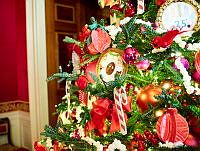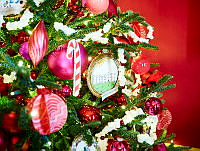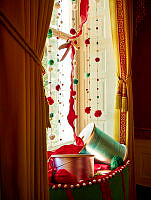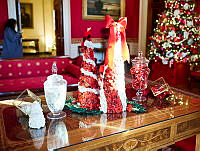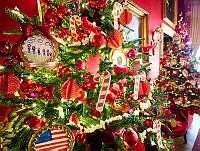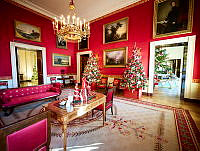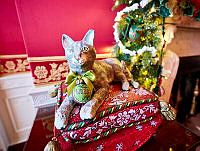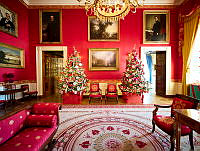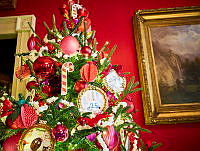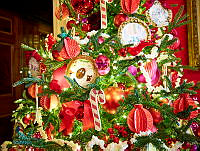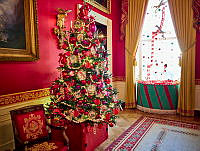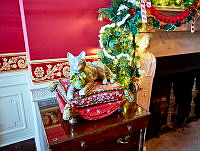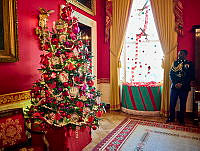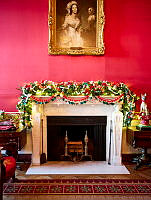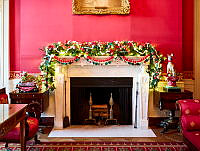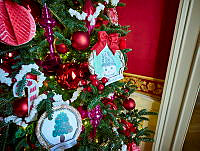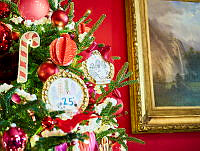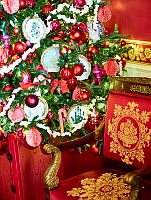Rubenstein Center Scholarship
A Secret Visit
A Presidential Portrait and Jacqueline Kennedy's Return to the White House

This oil on canvas portrait of President John F. Kennedy was painted by Aaron Shikler and is his official White House portrait. It was placed on public display in the East Room on February 5, 1971.
White House Historical Association/White House Collection"I wanted to let future generations know the man for what he was, a metaphor of America at a crossroads, not just handsome Jack.”- Aaron Shikler1
On November 22, 1963, President John F. Kennedy’s life was tragically cut short in Dallas, Texas. A state funeral was quickly planned and the nation grieved for its commander in chief while the Kennedy family mourned the loss of a father and husband. After the funeral, Jacqueline Kennedy made plans to quickly move her family out of the White House to make way for President Lyndon Johnson and his family. On December 6, 1963, two weeks after the president’s death, the Kennedys departed the White House.2 During the rest of her lifetime Jacqueline Kennedy returned to the White House only once. On February 3, 1971, she visited the Executive Mansion with her children to view the recently completed portraits of herself and her husband at the invitation of President Richard Nixon and First Lady Patricia Nixon.

This oil on canvas portrait of First Lady Jacqueline Bouvier Kennedy was painted by Aaron Shikler. Her portrait was also placed on public display in the East Room on February 5, 1971.
White House Historical Association/White House CollectionSeveral years after the tragic events of November 1963, the official portraits of the former president and first lady were planned for the White House Collection. The White House Historical Association, which was founded by Mrs. Kennedy in 1961, commissioned portraits from New York artist Aaron Shikler. In the winter of 1968, Shikler began working on Mrs. Kennedy’s portrait, finishing it in February 1970. For this painting the former first lady posed during several sessions in her New York apartment and once later at Shikler’s studio.3
The result was a full-length portrait done in peach, mauve, and champagne tones, giving the painting an almost ethereal or ghostly quality. Gazing off to her left, she stands before a carved fireplace with her hands carefully placed at her side. Shikler said of the portrait, “I tried to show her inner strength. She has an impassioned quality. She has this great inner passion but it’s so strongly controlled. I tried to show in the hands that tension—stiffly under control but ready to coil out.”4

This photograph shows the Diplomatic Reception Room during the John F. Kennedy administration. The Diplomatic Reception Room serves as an entrance from the South Grounds of the White House for the first family and visiting foreign officials. The panoramic wallpaper, titled "Views of North America," depicts scenes from American history, and was produced by Jean Zuber et Cie in France. The wallpaper was installed under the direction of First Lady Jacqueline Kennedy in 1961. For the former first lady’s 1971 visit to the White House, her official portrait was displayed in the Ground Floor Corridor outside this room.
White House Historical AssociationThe portrait of President Kennedy was much more difficult to complete. With exception of one distant glance at Kennedy riding by in a car some years prior, Shikler had never even seen Kennedy while he was alive. Working from twenty-five photographs, including one of the president’s brother, Ted Kennedy, standing over his gravesite, Shikler began the portrait in the spring of 1970 and completed it that November. Shikler made charcoal sketches of each photograph before deciding on a pose. According to Shikler, “I found two gestures Kennedy used over and over that came through in the photographs. One was with his hands in his jacket pockets. The other was with his arms across his chest. That one worked for me.”5
Once completed, the oil on canvas painting was unlike any other presidential portrait hanging in the White House. All White House presidential portraits pay particular attention to the subject’s eyes. Sometimes presidents are depicted staring straight ahead as in John Singer Sargent’s portrait of Theodore Roosevelt. Other portraits have the subject looking off into the distance, like George Peter Alexander Healy’s famous portrait of Abraham Lincoln. Shikler’s portrait is unique because it depicts Kennedy looking down with his arms crossed. In an interview with the Washington Post, Shikler explained his decision not to paint Kennedy’s eyes:
“I painted him with his head bowed, not because I think of him as a martyr, but because I wanted to show him as a President who was a thinker. A thinking president is a rare thing…He was a man who lived a short life. I wanted to show this tremendous fate that sat on his shoulders. Everybody is asking me why I didn’t paint his eyes. Well, everybody goes after the eyes. All presidential portraits have eyes that look right at you. I wanted to do something with more meaning. I hoped to show a courage that made him humble.”6

In this photograph taken on April 22, 1965, guests listen to First Lady Claudia "Lady Bird" Johnson and Janet Auchincloss dedicate the Jacqueline Kennedy Garden to Jacqueline Kennedy. Mrs. Kennedy designed this garden as a counterpart to President John F. Kennedy's Rose Garden. Although, the former first lady did not attend the ceremony, she did see the garden during her February 1971 visit.
White House Historical AssociationAfter both portraits were finished, Mrs. Kennedy (by then known as Mrs. Onassis), gave final approval and a viewing in the White House East Room was scheduled for February 5, 1971. As the public geared up for the official unveiling of the portraits, Mrs. Kennedy made a secret trip to the White House on February 3. Prior to this visit, she had not returned to the White House because she thought it would be too painful and sad. The former first lady even declined an invitation for her own garden dedication ceremony with Lady Bird Johnson on April 22, 1965.7 Unsure about how she would feel reentering the house, Kennedy opted for a private tour with only President Richard Nixon and First Lady Patricia Nixon. Aside from the Nixons, only two people in the White House knew about her visit; Chief Usher Rex Scouten and White House Curator Clement Conger.8
President Nixon sent a small military jet to New York to fly the former first lady and her children, Caroline and John Jr., to Washington on the afternoon of February 3, 1971. The family arrived at the White House at 5:30 pm for a tour with First Lady Patricia Nixon. During the tour Mrs. Nixon showed the Kennedy family the changes that had been made to the White House and showed off some of the newest acquisitions to the White House Collection. These changes were of particular interest to Mrs. Kennedy, as it was her vision that sought to acquire and preserve historic artifacts while transforming the White House into a living museum.9
Although the paintings were to be displayed on easels in the East Room for their public unveiling, White House Curator Clement Conger made sure they were hanging in their intended locations for the Kennedy visit. The portrait of President Kennedy was hung in the Green Room, his favorite of the three State Floor parlors.10 It replaced an 1897 Claude Monet painting titled Morning on the Seine, Good Weather. This Monet painting had been donated by the Kennedy family to commemorate the slain president. In preparation for the new portrait it was relocated to the Residence on the Second Floor.11

Morning on the Seine, Good Weather is a landscape of the Seine River in France by renowned French Impressionist Claude Monet. The calm, tranquil depiction of the Seine was a gift of the Kennedy family in memory of President John F. Kennedy. Monet produced a series of paintings of the Seine from 1896 to 1897.
White House Collection/White House Historical AssociationContinuing a long-standing tradition first suggested by Edith Roosevelt in 1902, Jacqueline Kennedy’s portrait was hung in the Ground Floor Corridor just outside the Diplomatic Reception Room.12 The location was selected to honor Mrs. Kennedy’s hard work in renovating the Diplomatic Reception Room during her time as First Lady. It would also be one of the first paintings visitors could see upon entering the White House through the East Wing.13
As the portraits were presented, Mrs. Nixon stood apart from the Kennedy family in order to give them space. Mrs. Nixon later reflected, “I stood apart to let them view alone, I thought it was a family affair.”14 The family approved of the locations selected for the portraits and enjoyed both paintings. According to the first lady’s press aide Helen Smith, “Mrs. Nixon said they seemed very happy and that they like the portraits and approved of where they were hanging.”15
After the Kennedy family viewed the paintings they continued with the tour. A highlight for thirteen-year-old Caroline was her former schoolroom, the Third Floor Solarium. While they lived in the White House for nearly three years as young children, Caroline and John Jr. were both very surprised by the size of the Executive Mansion and its many rooms.16

This photograph shows Caroline Kennedy and other children in her kindergarten classroom situated in the White House Solarium. The Kennedy family was excited to see the Solarium again when they visited the White House in February 1971.
John F. Kennedy Presidential Library and Museum/NARAMrs. Nixon also showed off areas of particular significance to the family. Mrs. Kennedy finally got to see the Jacqueline Kennedy Garden which was dedicated in her honor in 1965. She also viewed the President’s Dining Room. This Second Floor room had special meaning for the former first lady because she had converted it from a bedroom to a dining room, refurbishing the room with antique wallpaper featuring scenes of the Revolutionary War and historic furnishings.17
Mrs. Nixon’s tour ended in the Second Floor Oval Room where President Nixon joined them for cocktails. The Nixons’ daughters, Tricia and Julie, joined the group for dinner as the two families dined on a seafood appetizer, beef tenderloin with artichokes and mushrooms, and souffle for dessert. The dinner was a light-hearted affair filled with laughter. Mrs. Nixon enjoyed being seated next to ten-year-old John Jr. and noted that he spent the dinner telling her “about a great car he got for Christmas that runs on a battery.”18

This type-written menu was discovered taped to the reverse of a clipping from the "Evening Star" from February 5, 1971, which described a meeting in the White House between former First Lady Jacqueline Kennedy and First Lady Pat Nixon. The menu provides an outline for the Nixons and Kennedys dinner at the White House on February 3, 1971.
Courtesy of Henry & Carole Haller and FamilyAfter dinner, President Nixon took over the tour and led the Kennedy family to the West Wing. On the way, the president stopped off at the White House kennel to show off the Nixon family dogs, King Timahoe, Vickie, and Pasha.19 When they arrived at the Oval Office, President Nixon showed Caroline and John Jr. where their father used to sit.
When the tour of the West Wing was over, it came time for the Kennedy family to depart the White House. They boarded the same military jet and returned to their home in New York. The next day Mrs. Nixon gave several statements to the press about the visit. She was very happy about how the visit had gone saying, “[Mrs. Kennedy] truly loved being back; she truly did,” and “We made the past live again for her.” Mrs. Nixon was also optimistic about the former first lady returning to the White House in the future telling reporters, “I think she’ll come again.”20

President John F. Kennedy looks on as Caroline Kennedy and John F. Kennedy, Jr. play in the Oval Office. When his children returned to the White House in February 1971 Richard Nixon showed them the Oval Office.
John F. Kennedy Presidential Library and Museum/NARASadly, Mrs. Nixon’s prediction never came true. The secret visit to view her husband’s portrait remained the only White House visit Jacqueline Kennedy Onassis would make after leaving the Executive Mansion in 1963. Despite the fact that she never returned afterwards, she and her children did enjoy their 1971 visit. Caroline and John Jr. each wrote short thank you notes to the Nixons. John Jr. wrote, “I can never thank you more for showing us the White House. I really liked everything about it.”21 His sister wrote, “All the rooms were so lovely and it was so sweet of you to take us around so specially.”22 Mrs. Kennedy also expressed her sincere thanks in a warm note written to Mrs. Nixon, “The day I always dreaded turned out to be one of the most precious ones I spent with my children.”23
















